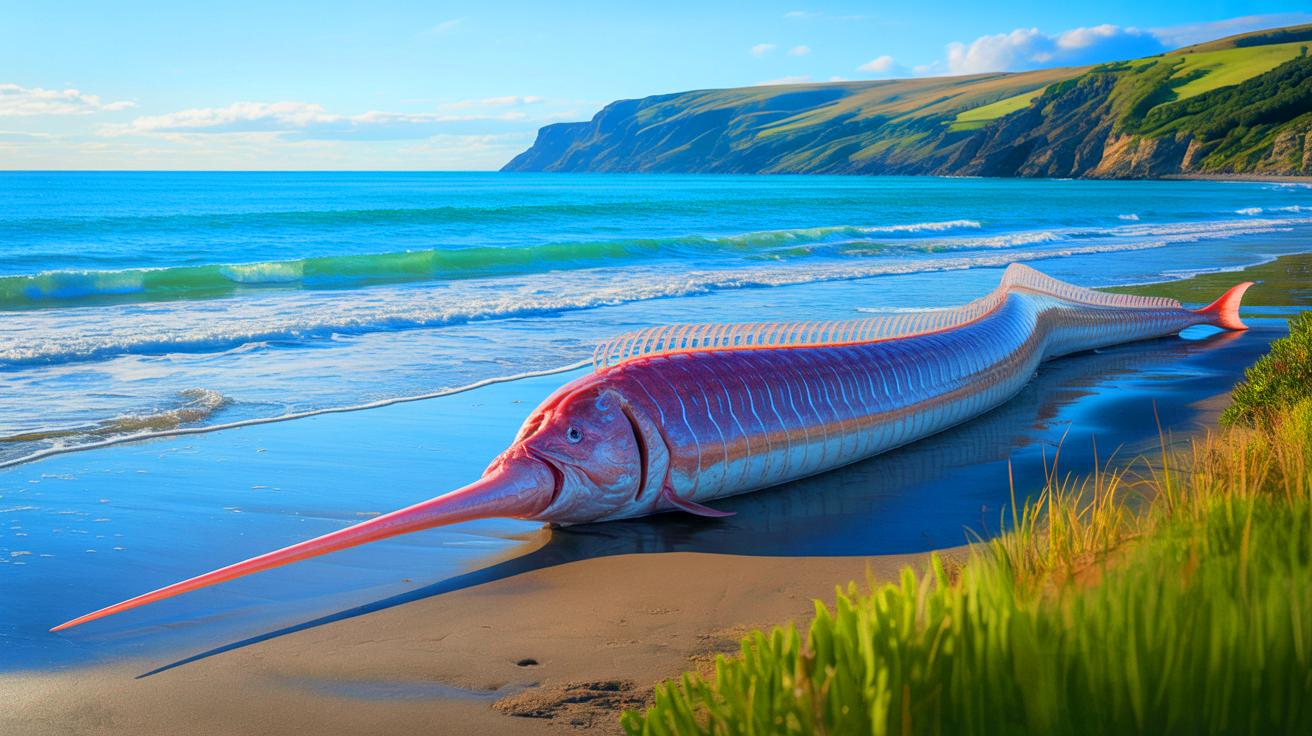- 🐟 Oarfish, often called the “fish of the apocalypse,” recently washed ashore in Tasmania and New Zealand, sparking intrigue.
- 🌊 These giant, mysterious sea creatures can reach up to 26 feet and are rarely seen, fueling myths and curiosity.
- 📚 Scientists emphasize there is no proven link between oarfish appearances and natural disasters like earthquakes.
- 📰 Chloé transitioned from sports journalism to wildlife reporting, exploring and writing about the natural world for GEO.FR.
The recent washing ashore of multiple giant oarfish on the coasts of Tasmania and New Zealand has reignited age-old myths surrounding these elusive sea creatures. Known as the “fish of the apocalypse,” the oarfish has historically been linked to ominous events, sparking both intrigue and fear. With their distinct, elongated bodies shimmering in silver and hues of blue and crimson, these rare sightings are a spectacle that captures the imagination. However, scientists urge a more rational perspective, emphasizing that the appearance of these deep-sea dwellers is not a harbinger of doom.
The Unusual Surge of Oarfish Sightings
The phenomenon began on Tasmania’s west coast, where the first oarfish, belonging to the Regalecidae family, was discovered beached. Shortly afterward, two more headless specimens appeared on New Zealand’s South Island, one in Aramoana and the other near Birdlings Flat. Their striking appearance, with bodies that can stretch up to 26 feet in length, makes them hard to miss. Andrew Stewart, fish curator at New Zealand’s Te Papa Tongarewa Museum, described these creatures as “magnificent and otherworldly” in an interview, emphasizing their repetitive body structure: “When you have an oarfish, you have 26 feet of repetition—each foot is identical to the previous one.”
Despite their fascinating appearance, the rarity of oarfish sightings persists. Stewart notes that only about twenty confirmed cases have been recorded in New Zealand. The museum had hoped to secure one of the specimens for research, but seagulls had already consumed the heads, depriving scientists of crucial data such as otoliths, teeth, and gill rakers. While these events stir curiosity and speculation, they remain isolated incidents rather than common occurrences.
Debunking Myths Around Oarfish and Natural Disasters
The oarfish’s eerie appearance and its occasional surfacing have long fueled myths associating it with natural disasters, particularly earthquakes and tsunamis. In Japan, these creatures, known as ryugu no tsukai, are thought to be messengers from the deep, warning of impending cataclysms. However, scientific studies, including one conducted in 2019, have found no correlation between oarfish appearances and seismic activity. Andrew Stewart emphasizes this point, advocating for a science-based approach devoid of superstition.
Oarfish inhabit the deep ocean, primarily in open oceanic areas, making their observation rare and contributing to the mystique surrounding them. Nick Ling, a fish ecologist at the University of Waikato, explains that this scarcity fuels numerous myths: “They live in the open ocean at significant depths, and people just don’t encounter them. Because of that, they are nearly impossible to study.” Ling also highlights their unique vertical swimming style, where they undulate their dorsal fins, calling them “truly beautiful fish” with an “extraordinary lifestyle.”
The Fascination with Abyssal Creatures
Beyond their mythical status, oarfish captivate scientists and the public alike due to their enigmatic existence. These deep-sea residents remain largely a mystery, with much of their biology and behavior still unknown. Their sudden appearances on shores offer rare opportunities for study, although such opportunities are often thwarted by natural predators or environmental factors.
For researchers, the chance to examine these creatures up close can provide invaluable insights into deep-sea ecosystems. However, the challenges of accessing intact specimens often limit scientific understanding. Despite these hurdles, oarfish continue to fascinate, drawing interest from marine biologists and enthusiasts worldwide. Their allure lies not only in their size and appearance but also in the secrets they hold about the Earth’s most uncharted frontiers.
Chloé’s Passionate Journey from Sports to Wildlife Reporting
Chloé’s journalism career began in areas far removed from mysterious sea creatures, focusing initially on women’s and sports media, particularly rugby and tennis. Yet, her passion for travel and wildlife always tugged at her heartstrings. Whether volunteering at a wildlife clinic in South Africa or swimming with orcas in Norway, her adventures have been diverse and thrilling. This passion led her to GEO.FR, where she now writes about animals and embarks on expeditions to explore their habitats.
Her diverse experiences enrich her storytelling, offering readers a glimpse into the wonders of the natural world. Chloé’s tales are not just about wildlife but also about the human connection to these creatures and the environments they inhabit. Her work invites readers to ponder the delicate balance of nature and the role we play in preserving it.
As we marvel at the enigmatic oarfish and the stories they inspire, we are reminded of the vast unknowns that still exist in our oceans. These creatures, while shrouded in mystery, also challenge us to deepen our understanding of marine life. What other secrets might the deep ocean hold, waiting to be discovered by curious minds?
Our author used artificial intelligence to enhance this article.
Did you like it? 4.7/5 (27)
